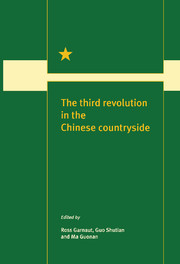Book contents
- Frontmatter
- Contents
- Figures
- Maps
- Tables
- Contributors
- Preface
- 1 The third revolution
- Feeding the people
- Marketing and price reform
- Internationalisation
- Regional issues
- Institutional change
- 18 China's rural property rights system under reform
- 19 ‘All the tea in China’: the reformation and transformation of the tea industry
- 20 The growth of rural industry: the impact of fiscal contracting
- References
- Index
19 - ‘All the tea in China’: the reformation and transformation of the tea industry
from Institutional change
Published online by Cambridge University Press: 04 August 2010
- Frontmatter
- Contents
- Figures
- Maps
- Tables
- Contributors
- Preface
- 1 The third revolution
- Feeding the people
- Marketing and price reform
- Internationalisation
- Regional issues
- Institutional change
- 18 China's rural property rights system under reform
- 19 ‘All the tea in China’: the reformation and transformation of the tea industry
- 20 The growth of rural industry: the impact of fiscal contracting
- References
- Index
Summary
Tea is an important rural industry that stands out for its low growth in the reform period, with production actually falling after 1988. Is it possible that this is a case in which the effects of reform have been unfavourable? Or is it economically efficient for tea not to expand?
Figure 19.1 reveals rapid growth in tea output between 1978 and 1988. This had very little to do with the post-1978 reform process. It takes about three years before a tea bush can be plucked. Bushes are generally considered to be mature from their eighth year onwards. Yields are typically highest between the ages of about 10 and 50 years and bushes can have a life of 100 years or more. Thus there is a substantial lag between planting and full production, linking the rapid output increases in the post-1978 period to preceding events.
Increases in recorded area planted during 1965–77, a period coinciding with the Cultural Revolution, averaged over 9 per cent per year. Over the five years to 1976 (figure 19.2), the planted area grew at the phenomenal rate of nearly 13 per cent per year. In 1973 and again the following year, 100 thousand hectares of tea were planted. This is equivalent to planting the total area under tea in South India, or Kenya, in just one year – or Sri Lanka's total tea area in two years!
- Type
- Chapter
- Information
- The Third Revolution in the Chinese Countryside , pp. 261 - 272Publisher: Cambridge University PressPrint publication year: 1996



